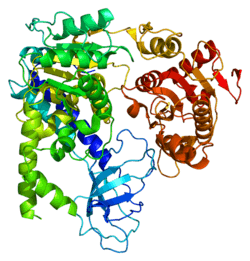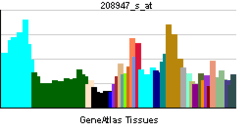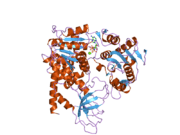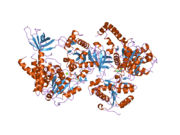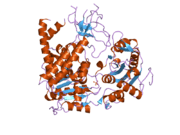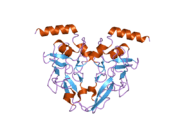UPF1
| View/Edit Human | View/Edit Mouse |
Regulator of nonsense transcripts 1 is a protein that in humans is encoded by the UPF1 gene.[3][4]
Function
This gene encodes a protein that is part of a post-splicing multiprotein complex, the exon junction complex, involved in both mRNA nuclear export and mRNA surveillance. mRNA surveillance detects exported mRNAs with truncated open reading frames and initiates nonsense-mediated mRNA decay (NMD). When translation ends upstream from the last exon-exon junction, this triggers NMD to degrade mRNAs containing premature stop codons. This protein is located only in the cytoplasm. When translation ends, it interacts with the protein that is a functional homolog of yeast Upf2p to trigger mRNA decapping. Use of multiple polyadenylation sites has been noted for this gene.[5]
Interactions
UPF1 has been shown to interact with:
References
- ↑ "Human PubMed Reference:".
- ↑ "Mouse PubMed Reference:".
- ↑ Perlick HA, Medghalchi SM, Spencer FA, Kendzior RJ Jr, Dietz HC (November 1996). "Mammalian orthologues of a yeast regulator of nonsense transcript stability". Proc Natl Acad Sci U S A. 93 (20): 10928–32. doi:10.1073/pnas.93.20.10928. PMC 38260
 . PMID 8855285.
. PMID 8855285. - ↑ Applequist SE, Selg M, Raman C, Jack HM (March 1997). "Cloning and characterization of HUPF1, a human homolog of the Saccharomyces cerevisiae nonsense mRNA-reducing UPF1 protein". Nucleic Acids Res. 25 (4): 814–21. doi:10.1093/nar/25.4.814. PMC 146496
 . PMID 9064659.
. PMID 9064659. - ↑ "Entrez Gene: UPF1 UPF1 regulator of nonsense transcripts homolog (yeast)".
- 1 2 Lykke-Andersen J (2002). "Identification of a human decapping complex associated with hUpf proteins in nonsense-mediated decay". Mol. Cell. Biol. 22 (23): 8114–21. doi:10.1128/MCB.22.23.8114-8121.2002. PMC 134073
 . PMID 12417715.
. PMID 12417715. - 1 2 3 Lejeune F, Li X, Maquat LE (2003). "Nonsense-mediated mRNA decay in mammalian cells involves decapping, deadenylating, and exonucleolytic activities". Mol. Cell. 12 (3): 675–87. doi:10.1016/S1097-2765(03)00349-6. PMID 14527413.
- 1 2 3 Yamashita A, Ohnishi T, Kashima I, Taya Y, Ohno S (2001). "Human SMG-1, a novel phosphatidylinositol 3-kinase-related protein kinase, associates with components of the mRNA surveillance complex and is involved in the regulation of nonsense-mediated mRNA decay". Genes Dev. 15 (17): 2215–28. doi:10.1101/gad.913001. PMC 312771
 . PMID 11544179.
. PMID 11544179. - 1 2 3 Schell T, Köcher T, Wilm M, Seraphin B, Kulozik AE, Hentze MW (2003). "Complexes between the nonsense-mediated mRNA decay pathway factor human upf1 (up-frameshift protein 1) and essential nonsense-mediated mRNA decay factors in HeLa cells". Biochem. J. 373 (Pt 3): 775–83. doi:10.1042/BJ20021920. PMC 1223536
 . PMID 12723973.
. PMID 12723973. - ↑ Mendell JT, Medghalchi SM, Lake RG, Noensie EN, Dietz HC (2000). "Novel Upf2p orthologues suggest a functional link between translation initiation and nonsense surveillance complexes". Mol. Cell. Biol. 20 (23): 8944–57. doi:10.1128/MCB.20.23.8944-8957.2000. PMC 86549
 . PMID 11073994.
. PMID 11073994. - 1 2 3 Lykke-Andersen J, Shu MD, Steitz JA (2000). "Human Upf proteins target an mRNA for nonsense-mediated decay when bound downstream of a termination codon". Cell. 103 (7): 1121–31. doi:10.1016/S0092-8674(00)00214-2. PMID 11163187.
Further reading
- Azzalin CM, Lingner J (2006). "The double life of UPF1 in RNA and DNA stability pathways". Cell Cycle. 5 (14): 1496–8. doi:10.4161/cc.5.14.3093. PMID 16861888.
- Horikoshi M, Sekimizu K, Natori S (1984). "Analysis of the stimulatory factor of RNA polymerase II in the initiation and elongation complex". J. Biol. Chem. 259 (1): 608–11. PMID 6200476.
- Nagase T, Seki N, Ishikawa K, et al. (1997). "Prediction of the coding sequences of unidentified human genes. VI. The coding sequences of 80 new genes (KIAA0201-KIAA0280) deduced by analysis of cDNA clones from cell line KG-1 and brain". DNA Res. 3 (5): 321–9, 341–54. doi:10.1093/dnares/3.5.321. PMID 9039502.
- Czaplinski K, Ruiz-Echevarria MJ, Paushkin SV, et al. (1998). "The surveillance complex interacts with the translation release factors to enhance termination and degrade aberrant mRNAs". Genes Dev. 12 (11): 1665–77. doi:10.1101/gad.12.11.1665. PMC 316864
 . PMID 9620853.
. PMID 9620853. - Page MF, Carr B, Anders KR, et al. (1999). "SMG-2 Is a Phosphorylated Protein Required for mRNA Surveillance in Caenorhabditis elegans and Related to Upf1p of Yeast". Mol. Cell. Biol. 19 (9): 5943–51. PMC 84455
 . PMID 10454541.
. PMID 10454541. - Bhattacharya A, Czaplinski K, Trifillis P, et al. (2000). "Characterization of the biochemical properties of the human Upf1 gene product that is involved in nonsense-mediated mRNA decay". RNA. 6 (9): 1226–35. doi:10.1017/S1355838200000546. PMC 1369996
 . PMID 10999600.
. PMID 10999600. - Mendell JT, Medghalchi SM, Lake RG, et al. (2000). "Novel Upf2p Orthologues Suggest a Functional Link between Translation Initiation and Nonsense Surveillance Complexes". Mol. Cell. Biol. 20 (23): 8944–57. doi:10.1128/MCB.20.23.8944-8957.2000. PMC 86549
 . PMID 11073994.
. PMID 11073994. - Serin G, Gersappe A, Black JD, et al. (2001). "Identification and Characterization of Human Orthologues to Saccharomyces cerevisiae Upf2 Protein and Upf3 Protein (Caenorhabditis elegans SMG-4)". Mol. Cell. Biol. 21 (1): 209–23. doi:10.1128/MCB.21.1.209-223.2001. PMC 88795
 . PMID 11113196.
. PMID 11113196. - Lykke-Andersen J, Shu MD, Steitz JA (2001). "Human Upf proteins target an mRNA for nonsense-mediated decay when bound downstream of a termination codon". Cell. 103 (7): 1121–31. doi:10.1016/S0092-8674(00)00214-2. PMID 11163187.
- Denning G, Jamieson L, Maquat LE, et al. (2001). "Cloning of a novel phosphatidylinositol kinase-related kinase: characterization of the human SMG-1 RNA surveillance protein". J. Biol. Chem. 276 (25): 22709–14. doi:10.1074/jbc.C100144200. PMID 11331269.
- Yamashita A, Ohnishi T, Kashima I, et al. (2001). "Human SMG-1, a novel phosphatidylinositol 3-kinase-related protein kinase, associates with components of the mRNA surveillance complex and is involved in the regulation of nonsense-mediated mRNA decay". Genes Dev. 15 (17): 2215–28. doi:10.1101/gad.913001. PMC 312771
 . PMID 11544179.
. PMID 11544179. - Lykke-Andersen J, Shu MD, Steitz JA (2001). "Communication of the position of exon-exon junctions to the mRNA surveillance machinery by the protein RNPS1". Science. 293 (5536): 1836–9. doi:10.1126/science.1062786. PMID 11546874.
- Carastro LM, Tan CK, Selg M, et al. (2002). "Identification of delta helicase as the bovine homolog of HUPF1: demonstration of an interaction with the third subunit of DNA polymerase delta". Nucleic Acids Res. 30 (10): 2232–43. doi:10.1093/nar/30.10.2232. PMC 115286
 . PMID 12000843.
. PMID 12000843. - Mendell JT, ap Rhys CM, Dietz HC (2002). "Separable roles for rent1/hUpf1 in altered splicing and decay of nonsense transcripts". Science. 298 (5592): 419–22. doi:10.1126/science.1074428. PMID 12228722.
- Lykke-Andersen J (2003). "Identification of a Human Decapping Complex Associated with hUpf Proteins in Nonsense-Mediated Decay". Mol. Cell. Biol. 22 (23): 8114–21. doi:10.1128/MCB.22.23.8114-8121.2002. PMC 134073
 . PMID 12417715.
. PMID 12417715. - Strausberg RL, Feingold EA, Grouse LH, et al. (2003). "Generation and initial analysis of more than 15,000 full-length human and mouse cDNA sequences". Proc. Natl. Acad. Sci. U.S.A. 99 (26): 16899–903. doi:10.1073/pnas.242603899. PMC 139241
 . PMID 12477932.
. PMID 12477932. - Chiu SY, Serin G, Ohara O, Maquat LE (2003). "Characterization of human Smg5/7a: A protein with similarities to Caenorhabditis elegans SMG5 and SMG7 that functions in the dephosphorylation of Upf1". RNA. 9 (1): 77–87. doi:10.1261/rna.2137903. PMC 1370372
 . PMID 12554878.
. PMID 12554878. - Schell T, Köcher T, Wilm M, et al. (2003). "Complexes between the nonsense-mediated mRNA decay pathway factor human upf1 (up-frameshift protein 1) and essential nonsense-mediated mRNA decay factors in HeLa cells". Biochem. J. 373 (Pt 3): 775–83. doi:10.1042/BJ20021920. PMC 1223536
 . PMID 12723973.
. PMID 12723973.
